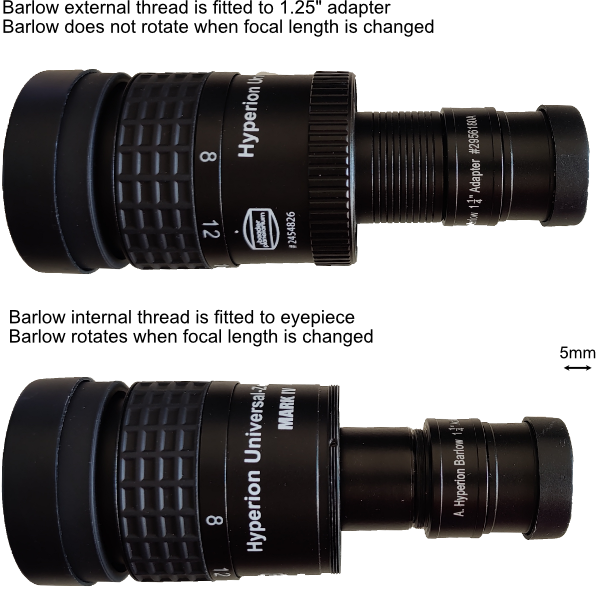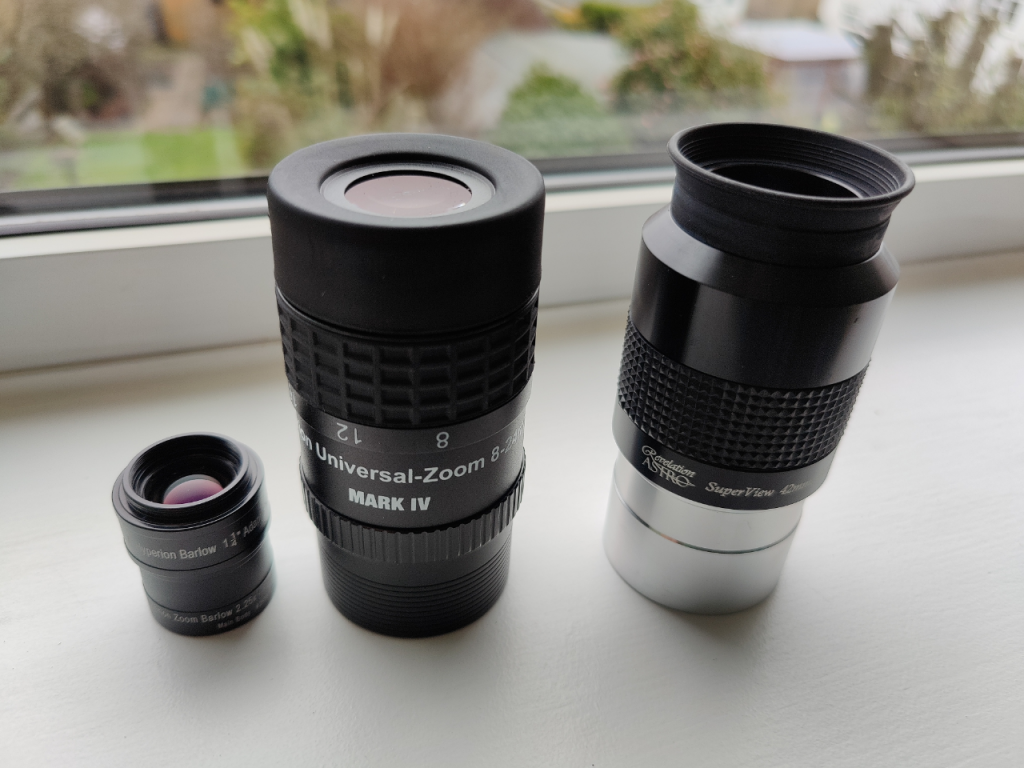The “stock” eyepieces that came with my 8″ 200P Dobsonian were great for me to get started. A new owner should definitely get used to them before considering any “upgrade”.
For me, the stock 25mm produced good results but the 10mm was dim and I was disappointed with the clarity of what I was seeing.
I did consider going down the conventional path of getting a few, mid range (like BST Starguiders) or better eyepieces in the 4.5, 6, 8, 12, 15, 20mm range but in the end, I took a different path and chose a zoom eyepiece.
A Zoom eyepiece sounds like the perfect solution: a wide range of focal lengths available in a single ocular, to be changed as simply as twisting the barrel. Zoom eyepieces are of course a compromise. Budget zooms tend to have narrower fields of view at the long-focal-length end, they can be heavy, their many glass elements result in internal reflections and loss of contrast and brightness, and of course, they’re more expensive than a single mid-range eyepiece.
“With my 200P I have a 50X to 338X magnification range”
There are several advantages to a zoom. There is no need to swap out eyepieces in order to find the ideal focal length of the object being observed. You will have everything from 24 to 8mm with the twist of a hand. For a non-tracked telescope convenience and speed are useful features. At the short-focal-length end, they actually tend to have longer eye relief and wider fields of view than Plossls, Kellners, and Orthoscopics. With the addition of a low power, wide-angle eyepiece and a Barlow having just three oculars can be very convenient. With the 200P I have a 50X to 338X magnification range and no wasted glass.
With all optics, you get what you pay for. If you buy a very cheap zoom eyepiece, don’t expect it to perform anything like as well as a single eyepiece. I did consider a good budget zoom eyepiece like the Celestron 8-24mm or the Svbony SV 135. At twice the cost, the Baader Hyperion IV Zoom and Barlow combo is not a budget option but considering this is an all-in-one option you may be saving money in the long run. With bright, sharp, crisp images, a “widefield” AFOV ~70 @ 8mm, 2” mode with camera threads, Barlow friendly, comfortable eye relief with no blackouts or beaning it gets great reviews.
I cannot praise the Baader Hyperion IV Zoom and Barlow combination highly enough. It has made a massive difference to my observing in terms of what I can see and the convenience of my observing. The only other oculars I have are a pair of 2″ StellaLyra/Revelation/ GSO wide angle. These are ideal for targeting and observing wide-field objects like the Pleiades and Andromeda nebula.
With the 2″ supplied adapter fitted, I now no longer use 1.25″ eyepieces.
Recommendation
If you can afford the Baader Mk IV and matching Barlow it’s a great combination with a 2” 30mm wide angle eyepiece. However given the rave reviews on the astro forums, the Svbony SV135 combined with a SV215 planetary zoom would be an excellent alternative at a very good price.
Fitting the Barlow
Note that with the Barlow and supplied 2” sleeve, in order to achieve focus, the eyepiece needs to be withdrawn about 5mm.
Without the Barlow the focus tube sits a long way in the OTA. I have purchased an additional shorter 2” extender which I use as follows:
No Barlow: Short 35mm 2” extender
Barlow: Original 47mm 2” extender and short 35mm 2” extender.
You can fit the Barlow directly to the eyepiece shaft (Barlow turns as zoom changes) or to the 1.25” sleeve (Barlow does not rotate as zoom changes). I use the latter method with both sleeves fitted.

Specifications
| Baader Hyperion IV Zoom with 1200mm focal length reflector, 203mm diameter mirror, focal ratio 5.91. Maximum recommended magnification x406 | ||||||
EP Focal Length (with 2.25x Barlow) |
Magnification |
Apparent Field of View |
Eye Relief |
Field Stop |
True Field of View |
Exit Pupil |
8mm (3.6mm) |
150x (338x) |
68° |
19mm |
9.5mm |
0.45° |
1.5mm |
12mm (5.3mm) |
100x (225x) |
63° |
18.2mm |
13.2mm |
0.63° |
2mm |
16mm (7.1mm) |
75x (169x) |
58° |
17.4mm |
16.2mm |
0.77° |
3mm |
20mm (8.9mm) |
60x (135x) |
53° |
16.7mm |
18.5mm |
0.88° |
3mm |
24mm (10.7mm) |
50x (113x) |
48° |
16mm |
20.1mm |
0.96° |
4mm |
| Revelation GSO 2″ Wide Angle | ||||||
30mm |
40x |
68° |
22mm |
37mm |
1.7° |
5mm |
42mm |
29x |
58° |
30mm |
43mm |
2° |
7mm |
Summary
It may seem strange to spend half a much on an eyepiece as I did on my telescope but I am so glad I did just that.
Having said all this, I totally get why a few good fixed eyepieces could be the best option for many. There are plenty of recommendations on r/telescopes, Star Gazers Lounge and Cloudy Nights.

Focal Length of Eyepiece – The distance between the lens and point of focus (focal plane).
Magnification – How much bigger an object will appear (power).
Apparent Field of View – How much of the sky the eyepiece can see before it is fitted to the telescope
True Field of View – How much of the sky the eyepiece can see when in the telescope
Field Stop – The aperture (opening) that limits the field of view of the eyepiece.
Exit Pupil – The size of the image in the eyepiece. It should match the size of your pupil at night. For a 30-year old this is typically 7mm, reducing by 1mm per decade, so for a 60-year old, it will be 4mm. All figures are averages
Eye Relief – How far your eye should be from the eyepiece to see all the field of view

Spot on. After numerous eyepiece purchases I too ended up settling with the Baader MkIV zoom and barlow and for wide field the Baader Aspheric 36mm. Mag range 46x-320x with zoom and barlow and 31x with the 2″ Aspheric. I’m getting superb views through my 102ed f11 and only 3 things to faff around with. Less eyepiece changing=More observing time! 10/10
Very well done Brett. I too have arrived at the low power wide view eyepiece combined with my Baader Hyperion 8-24 zoom as my main eyepiece set in my 12″ Apertura AD12 Dob and my Astro Tech AT102ED refractor. I use an Agena Astro 2″ 38 mm/70 and a Meade 2″ 20 mm/82 as for my low power wide view eyepieces.
I also have a full range of 1.25″ Explore Scientific 82 degree eyepieces. So I have a choice of which eyepieces to use, ES82 or the BH Zoom. At least 80% of the time it is the zoom that goes into the focuser, not the ES 82s.
Having both also lets me compare the quality of the image. I don’t think I give up anything going from the ES82s to the BH Zoom. Naturally, the ES82s are wider than the BHZ, but the ability to get to that perfect magnification every time is just too powerful for me to give it up to go to the single FL eyepieces.
I don’t have the BHZ Barlow. In my Orion XT8i I used a 1.5X/2X Barlow. In that scope I would screw the 1.5X Barlow element right onto the BHZ which gave me 75X to 225X. For that scope and my local conditions, that was a perfect match and kept me in the wider AFOV range of the zoom most of the time. But when conditions were extremely good, I would put it into the 2X Barlow for 100X to 300X. It was rare that I could take it higher than that, except on the Moon.
One or two low power wide view and a BH Zoom with a Barlow option is all you need for an excellent evening of observing
Hi
I have the same set up as you . Can you please show me how you overcome the focus issues , with and without the Barlow attached, with pictures would be really useful. Thanks
I explain how to achieve focus in the article so I am not sure what else you are referring to, sorry.
Thank you for the article!
Do you have any experience with looking through the eyepiece with glasses? I’m considering to buy the Hyperion Zoom but I’m unsure whether the eye relief (16-19mm) is wide enough or not for a comfortable use with glasses on.
And you are saying, that the eye relief gets longer when the magnification gets higher. I heard from other users, that it’s the opposite way. Can you comment on this issue?
I don’t wear glasses so I am not best to comment but posting on forums indicates that the 12-15mm eye relief is not an issue for those that do.
Hey Brett,
I recently purchased the Baader Zoom with matching barlow. I am struggling to understand why anyone would screw the barlow directly onto the zoom lens as opposed to the 1.25″ adapter which is suggested by Baader. What benefit is there for the barlow to rotate whilst changing the focal length?
Is it purely to achieve the 2.25x as opposed to the 2.35x you get when using the 1.25″ adapter? Any clarification here would be greatly appreciated!
I plan to use the zoom and barlow with the 2″ skirt fitted.
Cheers,
Gus
The Barlow fitting options I agree are bizarre and confusing and that is why I created this page on my blog. As to why they offered the option to fit it directly to the EP, perhaps you could ask them and post their response here?